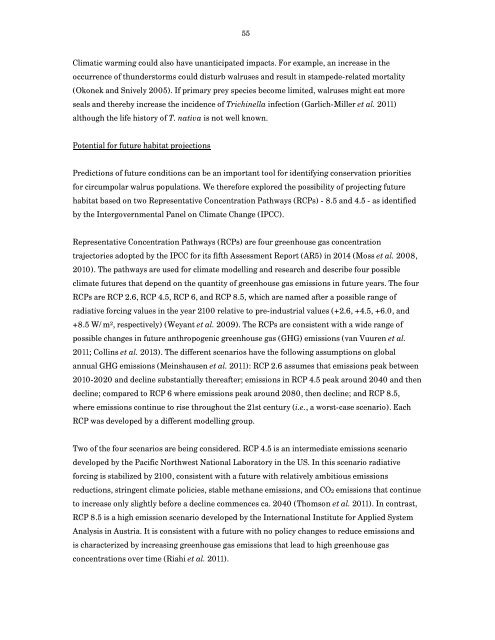The State of Circumpolar Walrus Populations
walrusreport
walrusreport
You also want an ePaper? Increase the reach of your titles
YUMPU automatically turns print PDFs into web optimized ePapers that Google loves.
55<br />
Climatic warming could also have unanticipated impacts. For example, an increase in the<br />
occurrence <strong>of</strong> thunderstorms could disturb walruses and result in stampede-related mortality<br />
(Okonek and Snively 2005). If primary prey species become limited, walruses might eat more<br />
seals and thereby increase the incidence <strong>of</strong> Trichinella infection (Garlich-Miller et al. 2011)<br />
although the life history <strong>of</strong> T. nativa is not well known.<br />
Potential for future habitat projections<br />
Predictions <strong>of</strong> future conditions can be an important tool for identifying conservation priorities<br />
for circumpolar walrus populations. We therefore explored the possibility <strong>of</strong> projecting future<br />
habitat based on two Representative Concentration Pathways (RCPs) - 8.5 and 4.5 - as identified<br />
by the Intergovernmental Panel on Climate Change (IPCC).<br />
Representative Concentration Pathways (RCPs) are four greenhouse gas concentration<br />
trajectories adopted by the IPCC for its fifth Assessment Report (AR5) in 2014 (Moss et al. 2008,<br />
2010). <strong>The</strong> pathways are used for climate modelling and research and describe four possible<br />
climate futures that depend on the quantity <strong>of</strong> greenhouse gas emissions in future years. <strong>The</strong> four<br />
RCPs are RCP 2.6, RCP 4.5, RCP 6, and RCP 8.5, which are named after a possible range <strong>of</strong><br />
radiative forcing values in the year 2100 relative to pre-industrial values (+2.6, +4.5, +6.0, and<br />
+8.5 W/m 2 , respectively) (Weyant et al. 2009). <strong>The</strong> RCPs are consistent with a wide range <strong>of</strong><br />
possible changes in future anthropogenic greenhouse gas (GHG) emissions (van Vuuren et al.<br />
2011; Collins et al. 2013). <strong>The</strong> different scenarios have the following assumptions on global<br />
annual GHG emissions (Meinshausen et al. 2011): RCP 2.6 assumes that emissions peak between<br />
2010-2020 and decline substantially thereafter; emissions in RCP 4.5 peak around 2040 and then<br />
decline; compared to RCP 6 where emissions peak around 2080, then decline; and RCP 8.5,<br />
where emissions continue to rise throughout the 21st century (i.e., a worst-case scenario). Each<br />
RCP was developed by a different modelling group.<br />
Two <strong>of</strong> the four scenarios are being considered. RCP 4.5 is an intermediate emissions scenario<br />
developed by the Pacific Northwest National Laboratory in the US. In this scenario radiative<br />
forcing is stabilized by 2100, consistent with a future with relatively ambitious emissions<br />
reductions, stringent climate policies, stable methane emissions, and CO2 emissions that continue<br />
to increase only slightly before a decline commences ca. 2040 (Thomson et al. 2011). In contrast,<br />
RCP 8.5 is a high emission scenario developed by the International Institute for Applied System<br />
Analysis in Austria. It is consistent with a future with no policy changes to reduce emissions and<br />
is characterized by increasing greenhouse gas emissions that lead to high greenhouse gas<br />
concentrations over time (Riahi et al. 2011).


